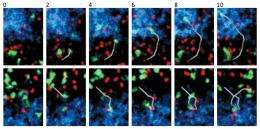Ensuring the persistence of immune memory

Structures within the lymph nodes known as germinal centers (GCs) help the body to maintain long-term immune defense against foreign threats. The GCs essentially act as sites where antibody-producing B cells undergo a process of ‘evolution’ to generate higher-quality antibodies. This evolutionary mechanism is in turn supported by a class of T cells known as follicular helper T (Tfh) cells.
Takaharu Okada and colleagues at the RIKEN Research Center for Allergy and Immunology in Yokohama recently tracked the process of B cell development in mouse GCs by monitoring expression of Bcl61. This protein facilitates B cell evolution by regulating expression of key developmental genes.
The researchers were surprised to note a broader scope of Bcl6 activity than expected. “It became apparent that Bcl6 is important for Tfh cells as well,” says Okada, “and I felt that we should track [the levels of] Bcl6 expression in both B and T cells at the same time.”
They quantified Bcl6 levels by generating transgenic mice in which a DNA fragment encoding a fluorescent protein had been inserted into one copy of the Bcl6 gene. Since this insertion partially disrupted Bcl6 function, this reporter system enabled the researchers to examine the effects of inhibiting this protein.
Following the induction of an immune response in the animals, Okada and colleagues observed an increase of Bcl6 expression in antigen-specific B cells within peripheral regions of the lymph node; these subsequently migrated to the GC, where they continued to strongly express Bcl6 (Fig. 1).
This migration and maturation process is dependent upon interaction with Bcl6-expressing helper T cells. All T cells expressing high levels of Bcl6 became Tfh cells, but many Tfh cells subsequently reduced Bcl6 production to varying degrees. Okada was surprised that the dynamics of Bcl6 expression differed between B and T cells. “This suggests that they employ different mechanisms for regulating expression of this important transcription factor,” he says.
Okada and his team also recorded observations suggesting that Tfh cells expressing low levels of Bcl6 may give rise to ‘memory cells’, which enable the immune system to react quickly to recurring threats. However, this will require further investigation.
Understanding how these various cells employ this shared regulatory factor will also be a top priority moving forward. “We would like to learn the molecular mechanisms of Bcl6 expression in B and T cells by setting up collaborations with experts in the field of gene and protein expression control,” says Okada.
More information: Kitano, M., et al. Bcl6 protein expression shapes pre-germinal center B cell dynamics and follicular helper T cell heterogeneity. Immunity 34, 961–972 (2011)














